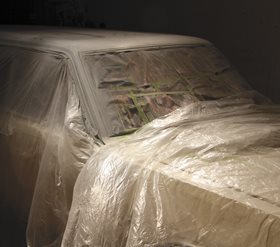.aspx) The Howlett keeps on giving
The Howlett keeps on giving
Bevan Honey by Nikki Miller
When the opportunity came to subscribe to Bevan Honey’s Mark Howlett Foundation Commission (MHFC) in 2008 it was a no-brainer for me: help support Bevan make work and receive an artwork in return at the end of the process. The question was, what difference would this support make, if any, to his practice?
Over 20 years the Mark Howlett Foundation (MHF) did many good things for artists but at its very core was support for 14 mid-career Western Australian artists. It was a pioneering model of support for the visual arts in this State, a prototype of crowdfunding before the word had been invented.
For Bevan it was, “…a fantastic thing to be offered. To have faith shown in your practice before you do it…”
Bevan Honey’s impressive CV documents one of this State’s most consistent artists. However, in conversation he reveals something the CV doesn’t: how enormously influential the MHFC has been to his subsequent output.
Offered uninterrupted time to create, Bevan did the sensible thing and “went nuts” pursuing all of his ideas.
 “I lacked restraint initially, everything was quite unfinished,” he says.
“I lacked restraint initially, everything was quite unfinished,” he says.
But towards the middle of the MHF term, with the grip of an approaching deadline, he reined in his focus.
In the 2009 catalogue to Bevan’s MHF#13 show there is a lengthy quote describing his intention to draw every day of the commission, and the challenges and learning arising from this self-set task. Five years later the artist smiles as I read him this quote and confirms that he still recalls the drawing process as the defining event of his MHF Commission. “Drawing was the constant,” Bevan says.
Some of those early MHF drawings show forms rising into three dimensions. These same forms keep emerging and evolving in his subsequent shows – two solo shows at Galerie Dusseldorf (2009, 2012) and another at Perth Institute of Contemporary Arts (PICA) in 2010. A resurging confidence was evident in the PICA show, culminating in his drawing machine entitled ‘Burn Out (state dependent memory)’. At its essence are several of Bevan’s recurrent artistic concerns: probing our constructed environment; excess; and obsession. This, like all great artwork, reveals ineffable, subtle truths and keeps giving when you return to it.
Bevan’s only reservation about the MHF Commission is one he ascribes to his own inexperience. That is, by fully throwing himself into an 18-month commission, it removed him from his regular exhibition regime. This was time lost to forging interstate and other connections. Back in 2008 the Howlett Foundation had no cache beyond the borders of Western Australia, although the MHF Board subsequently took steps to address this by initiating both a touring show and significant publication. Bevan’s observation is an interesting one, not the least because it reveals a savviness with the machinations of the contemporary artworld.
Which leads to the most surprising revelation about his MHF experience; for this artist, it was “more important to go on the Board” than to receive the actual commission. Through the MHF Board meetings he learned much about the structure of the artworld. It was eye-opening to witness how and why decisions are made.
Nevertheless, “The Howlett” counts for Bevan as the most significant support for his career to date. As for my investment? Five years on, I’m still learning the significance of the MHFC#13.
Nikki Miller is an arts consultant with Art Support Pty. Ltd and is a former Manager of Artsource.
This article featured in the Artsource Newsletter, Winter 2013.